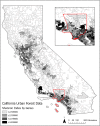Urban forest biodiversity and cardiovascular disease: Potential health benefits from California's street trees
- PMID: 34731162
- PMCID: PMC8565780
- DOI: 10.1371/journal.pone.0254973
Urban forest biodiversity and cardiovascular disease: Potential health benefits from California's street trees
Abstract
Enhanced immune functioning in response to biodiversity may explain potential health benefits from exposure to green space. Using unique data on urban forest biodiversity at the zip code level for California measured from 2014 to 2019 we test whether greater diversity of street trees is associated with reduced death from cardiovascular disease. We find that urban forests with greater biodiversity measured via the Shannon Index at the genus level are associated with a lower mortality rate for heart disease and stroke. Our estimates imply that increasing the Shannon Index by one standard deviation (0.64) is associated with a decrease in the mortality rate of 21.4 per 100,000 individuals for heart disease or 13% and 7.7 per 100,000 individuals for stroke or 16%. Our estimates remain robust across several sensitivity checks. A policy simulation for tree planting in Los Angeles based on our estimates suggests that if these relationships were causal, investment in planting for a more biodiverse set of street trees would be a cost-effective way to reduce mortality related to cardiovascular disease in urban areas.
Conflict of interest statement
No authors have competing interests.
Figures




References
-
- Center for Disease Control (CDC). Vital Signs: Avoidable Deaths From Heart Disease, Stroke, and Hypertensive Disease–United States 2001–2010. 2013. https://www.cdc.gov/mmwr/preview/mmwrhtml/mm6235a4.htm?s_cid=mm6235a4_w. - PMC - PubMed
-
- Center for Disease Control (CDC). CDC Estimates Preventable Deaths from 5 Leading Causes. 2016. https://www.cdc.gov/media/releases/2016/p1117-preventable-deaths.html.
-
- World Health Organization (WHO). Prevention of Cardiovascular Disease: Guidelines for Assessment and Management of Cardiovascular Risk. 2007. https://www.who.int/cardiovascular_diseases/guidelines/Full%20text.pdf.
Publication types
MeSH terms
LinkOut - more resources
Full Text Sources
Medical

